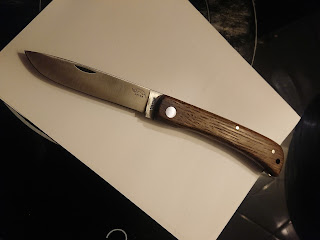In Germany, the knife was really common with miners, farmers and working class people. Locking versions were often referred to as "Notschlachter" (emergency butcher knife). To understand this, one must know that most miners, locksmiths and smiths also had a small garden and kept chicken, a goat and /or rabbits, because first and foremostly, food was not as readily available as it is nowadays and secondly, their salary in the heavy industry could not pay for luxuries as food. I mean, they had to be glad to have work, innit? 😁 The knife would serve as a tool to butcher chicken and rabbit, for repairs in the house and garden, and for eating. Like the "Henkelmann" (double pot), it was an icon of the every day toil of the common people.
The Nether German name "Hippekniep" is pretty interesting in itself. It is commonly translated as "goat knife", because as I said, a lot of the common people had goats for milk. In Nether German, a "Hippe" also refers to a goat. It is, on the other hand, also a name for a billhook used for pruning trees. There is a special kind of bread and household knife with a sheepfoot blade that is called "Hepchen". The shape is found with small paring knives as well as bread and chef knives. With these applications, the word might be cognate with the diminutive "Häppchen", which refers to a bite - sized morsel in Germany. This leads me to the assumption that in this case, it is not referring to the goat, even if it looks plausible at first, but rather derives from Old Nether German *hapan or Gothic *hepjan, which has the meaning of hewing or dividing into parts. "Kniep" is Nether German for "knife", and you can see the close relation of the two words. If you want to follow my assumption, "Hippekniep" would mean "cutting" or "hewing knife". Actually it will not do well in hewing, but we will see whether or not it cuts... ☺️
Out of the box, it came shaving sharp. The handle is made from locally sourced and smoked oak. The liners are made of thick steel, the slipjoint spring is rather stiff. Bit of a pain in the arse to open with cold fingers, but great stay. The knife came with no play and is put together with a big steel rivet, which looks sturdy and has no hotspots. All pins are made from steel. At the end of the handle there is a small (4mm)lanyard hole, without a brass tube or anything. Actually I am not quite sure if it is a good idea. It is not that the blade will cut into the lanyard if you close it, but it will if you push it the slightest against the spring when you close it. Some old Hippekniep I saw often had no lanyard hole at all, or a ring, often handmade by the owner, threaded through a smaller hole.
The blade sits in the handle well centered. Overall craftsmanship is more than adequate.
The blade is made from C75 carbon steel, tempered to 56-58 HRC. This is not exhausting the hardness potential of the steel at all, resulting in a very resilient blade. It has a high convex bevel to almost zero. Thickness above the edge on mine is just 0,2mm, overall the spine thickness is 2,3 mm. The blade is 98mm long, making it possible to cut a piece of bread without too many crumbling. ☺️
I took it to the woods, and while it obviously is no specialized carving knife, it did surprisingly well for a slipjoint. The stay of the stiff spring adds safety. I would very much like some half stop, but alas for production line efficiency, this will not come to be.
The knife really shines when harvesting vegetables and preparing food.
It is also a wonderful eating knife.
Snacking is a cinch, and it adds flair to your rustic snack board dishes. It would also be a great companion to a BBQ or to a steakhouse dinner.
It is obviously no specialized bushcraft knife either, but you can strike sparks from a ferro rod and prepare awesome feather sticks. The spine can be used for scraping, but you need to be careful, it is a slipjoint knife after all. But it is a really valuable companion for foraging herbs and mushrooms, and it also doesn't scare the shite out of people if you use it in public, quite the contrary.
In Germany, it is available for less than 80€. If you are looking for a sturdy, reliable and sensible tool for the house and garden which is a legal carry almost everywhere in Germany and has a built - in legal reason and a long history, well, buy it. It is not a display queen, but it works.


















